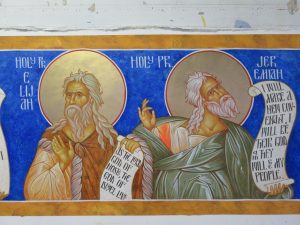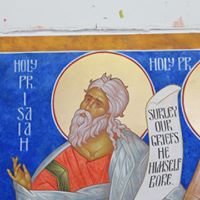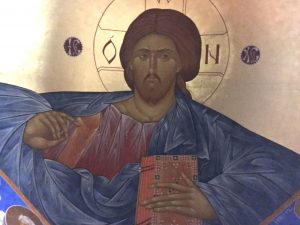Dome Iconography
Observations from Fr. Robert
With the installation of the new icons in the dome, we have a rich opportunity during this Lenten Season to allow these icons to form our minds and hearts in the truths of the Orthodox Faith and the Sacred Scripture. I will use this space to give an outline of some of the important aspects that these icons teach us. In addition, next week at the end of the Liturgy, I will invite individual children from the parish to give a short presentation to the parish about one of the prophets, and that prophet will be a source of focus for the Church school that week.
First, it was a special blessing to begin the installation of the Pantocrator (Greek: “Ruler of All”) on the Sunday of Orthodoxy – where the Church celebrates not only the victory over iconoclasm (in the 9th century), but the whole meaning of iconography as it leads us to a deeper awareness of the presence of Christ ‘in our midst’. This is an affirmation of the Orthodoxy of our parish – as sanctified by the presence of Christ as attested by the holy prophets.
There is much that can be said about the Pantocrator icon – to begin, let us ponder the following:
“The gigantic images of the Pantocrator on the mosaics and frescos of Byzantine cupolas, have a monumental style, which underlines the formidable aspect of the Lord, the Ruler of the Universe, Who will come to judge the quick and the dead…[Other Pantocrator images] while still keeping the same majesty, lacks all the fearfulness. The grave expression on His face is full of sweetness; it is the compassionate Lord, come to take on Himself the sins of the world.” [The Meaning of icons, Ouspensky/Losskyp.73]
The icon in our dome is a rich combination of both themes – showing both majesty and power, yet mercy and compassion – blessing and judgment – in the fullness of spiritual harmony.
As the Sunday of Orthodoxy reminds us, this icon communicates these truths to us:
Jesus Christ is Almighty, and the Lord of All Creation – He is the Living Word, “ through Whom all things were made (cf. Gen.1, Jn.1:1, The Nicene Creed) This profession is at the very core of our Christian Faith, repeated from the earliest times, and recorded in the Scriptures “Jesus Christ is Lord’ (Phil. 2). This Lordship affirms the Divine Nature of the Son of God – He is truly God (light from fight, true God from true God). The image of Christ is surrounded by the brilliance of 23k gold leaf – reflecting the ambient fight, as creation reflects the true light of Christ. We must never despise creation – as Jesus Christ is its Lord!
Jesus is the Incarnate Son of God: As the uncreated God, as affirmed by the Seventh Ecumenical Council and the Triumph of Orthodoxy (above), the only reason why an image may be painted of Jesus, is because He has taken flesh of the Virgin Mary, and became man – which we celebrate at the Feast of the Annunciation later this month and the Nativity of our Lord (Dec. 25). So what the icon portrays, always, is the human nature of us – now participating in this divine (hypostatic) union with the Godhead. Jesus is human as He is also divine. His humanity remains fully joined to his divinity – into eternity. Through the incarnation, humankind is restored to its rightful place in creation, as God intended. Jesus is the New Adam, through Whom the world and creation, fallen in sin, is now being restored.
Jesus Blesses Us – and His Creation: This truth is manifest specifically in the holding of his hand in the form of bestowing a blessing. The blessing is a reminder of his blessing of the Apostles, “Peace be with you. ’’when He came into their midst after the Resurrection (Jn. 20). Not only does He come to bless us, but as Pantocrator He blesses all of creation. His glory illumines creation as the sun brings the light of day to the world. The divine presence, through the saving work of Christ, and the grace of the Holy Spirit renders God as present ’everywhere’ and ’filling all things’.
Jesus Will Come Again: The second Sunday preceding Great Lent reminded us of the coming of Christ again – in glory – to judge the living and the dead. (Nicene Creed) As we live in the age when humankind is being transformed by Christ through His Incarnation, and His saving Death and Resurrection, so also are we reminded that this process of transformation is brought to completion by His grace. Appropriately, on this Second Sunday of Great Lent, we are reminded of this through the exemplary teachings of St. Gregory Palamas, who helps us to better understand this  transformation as ‘theosis’. As St. Athanasius affirmed in his work, On the Incarnation, ‘God became man so that man might become God.’ So we see that by Christ’s saving work, we are ‘becoming God’ – that the likeness of God stamped on our persons and sealed in the Spirit is growing ever more perfectly in our lives if we follow Christ in our spiritual walk. Likewise, an ‘hour will come’ when then Christ will come again in glory, the dead shall be raised, and He will gather us – for the Last Judgment. The book of the Gospels (or sometimes portrayed as the Book of Life) in the icon, is sometimes painted with an inscription to this effect.
transformation as ‘theosis’. As St. Athanasius affirmed in his work, On the Incarnation, ‘God became man so that man might become God.’ So we see that by Christ’s saving work, we are ‘becoming God’ – that the likeness of God stamped on our persons and sealed in the Spirit is growing ever more perfectly in our lives if we follow Christ in our spiritual walk. Likewise, an ‘hour will come’ when then Christ will come again in glory, the dead shall be raised, and He will gather us – for the Last Judgment. The book of the Gospels (or sometimes portrayed as the Book of Life) in the icon, is sometimes painted with an inscription to this effect.
There is much more that can be said of this icon, and it will be for us a continuing reminder of this time, and us as a people whom God has blessed with His presence, His saving ministry, the Holy Mysteries leading to salvation and sanctification. May He be glorified in our hearts – and may we radiate his image in our own lives!
Icons of the Prophets:
Zephaniah
Amos
Baruch
Daniel
David
Elijah and Jeremiah
Elisha
Ezekiel
Isaiah
Jeremiah
Joel
Malachi
Micah and Samuel
Obadiah
Samuel
Zachariah

